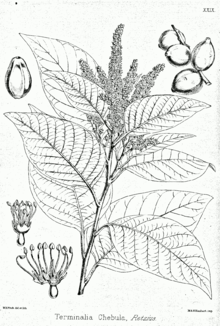Terminalia chebula
| Terminalia chebula | |
|---|---|

| |
| A leafless T. chebula tree | |
| Scientific classification | |
| Kingdom: | Plantae |
| Clade: | Tracheophytes |
| Clade: | Angiosperms |
| Clade: | Eudicots |
| Clade: | Rosids |
| Order: | Myrtales |
| Family: | Combretaceae |
| Genus: | Terminalia |
| Species: | T. chebula
|
| Binomial name | |
| Terminalia chebula | |
| Synonyms[1][2] | |
| |
Terminalia chebula, commonly known as black- or chebulic myrobalan,[3] is a species of Terminalia, native to South Asia from Pakistan,
Taxonomy
Swedish naturalist Anders Jahan Retzius described the species in Observ. Bot. 5: 31 in 1788.[1]
Many varieties are known, such as:[4]
- T. c. var. chebula – leaves and shoots hairless, or only hairy when very young
- T. c. var. tomentella – leaves and shoots silvery to orange hairy
Description

Terminalia chebula is a medium to large
Distribution and habitat
Terminalia chebula Is found throughout southern and southeast Asia including in India, Sri Lanka, Bhutan, Nepal, Bangladesh, Myanmar, Cambodia, Laos, Vietnam, Indonesia, Malaysia, Pakistan and Thailand. In China, it is native in western Yunnan and cultivated in Fujian, Guangdong, Guangxi (Nanning), and Taiwan (Nantou).[6][7]
In India, it is found in the sub Himalayan region from Ravi, eastwards to western Bengal and Assam, ascending up to the altitude of 1,500 m (4,900 ft) in the Himalayas. This tree is wild in forests of northern India, central provinces and Bengal, common in Madras, Mysore and in the southern part of the Bombay presidency.[8]
Its habitat includes dry slopes up to 900 m (3,000 ft) in elevation.[9]
Cultivation and uses

This tree yields smallish, ribbed and nut-like fruits which are picked when still green and then pickled, boiled with a little added sugar in their own syrup or used in preserves. The seed of the fruit, which has an elliptical shape, is an abrasive seed enveloped by a fleshy and firm pulp. Seven types of fruit are recognized (vijaya, rohini, putana, amrita, abhaya, jivanti, and chetaki), based on the region where the fruit is harvested, as well as the colour and shape of the fruit. Generally speaking, the vijaya variety is preferred, which is traditionally grown in the Vindhya Range of west-central India, and has a roundish as opposed to a more angular shape.[9] The fruit also provides material for tanning leather and dyeing cloth.[7]
Terminalia chebula (called Haritaki
Chemical composition
A number of
Terminalia chebula also contains terflavin B, a type of tannin, while chebulinic acid is found in the fruits.[15]
The fruit extracts of Terminalia chebula also have
Gallery
-
A green fruit
-
A dried T. chebula by the side of a scale
-
Flowers
-
Trunk
References
- ^ a b "Terminalia chebula Retz. | Plants of the World Online | Kew Science". Plants of the World Online. Retrieved 16 November 2023.
- ^ "The Plant List: A Working List of All Plant Species". Retrieved 7 August 2015.
- ^ a b "Terminalia chebula Retz". Germplasm Resources Information Network. Agricultural Research Service, United States Department of Agriculture. Retrieved 6 Aug 2016.
- ^ a b c d Flora of China: Terminalia chebula
- ^ a b "The Ayurvedic Herb that Supports Immune & Gut Health". Dr. Axe. Retrieved 16 November 2023.
- ^ "Terminalia chebula".
- ^ a b "Terminalia chebula". efloras.org.
- PMID 23620847.
- ^ a b c "Todd Caldecott | Haritaki". Archived from the original on 2013-12-03. Retrieved 2014-05-18.
- PMID 28848436.
- PMID 12127233.
- S2CID 25751621.
- PMID 20659546.
- PMID 16747927.
- PMID 16922284.
- ^ Prathibha, S.; Jenitta, E.P.E.; Rama Bhat, P.; Jayadev, K.; Shetty, Shrinidhi (2015). "Green synthesis of silver nanoparticles from fruit extracts of Terminalia chebula Retz. and their antibacterial activity". International Journal of Research in Biosciences. 4 (2): 29-35.




